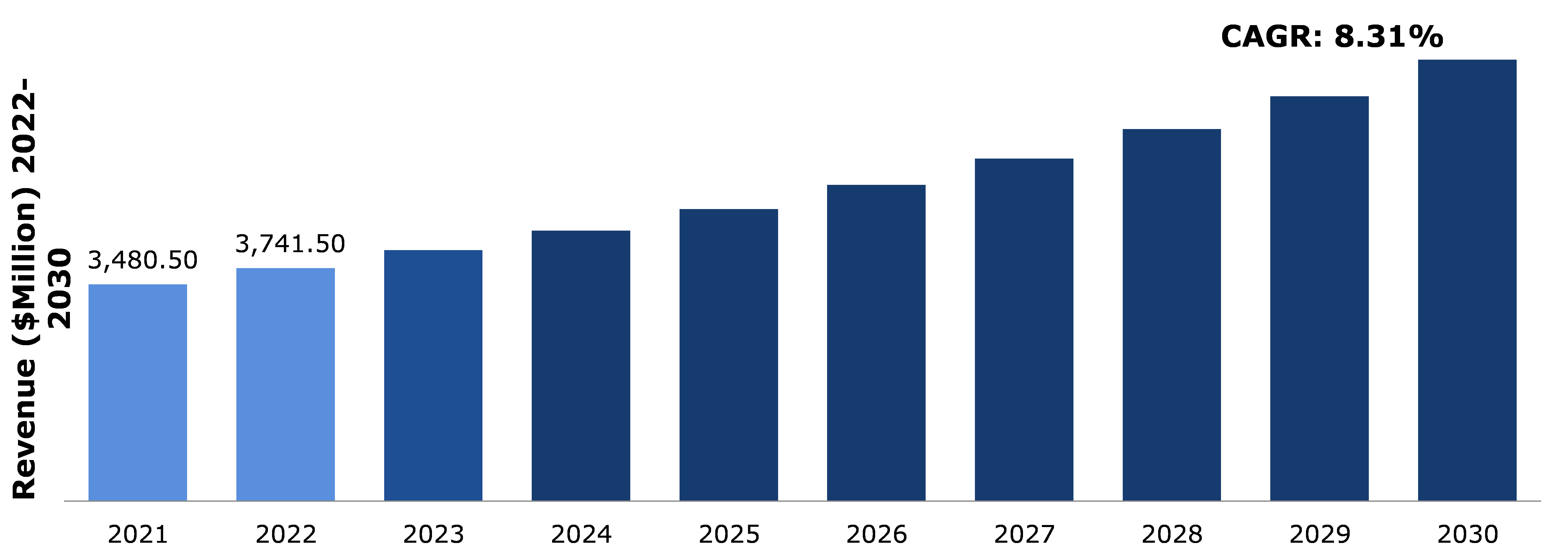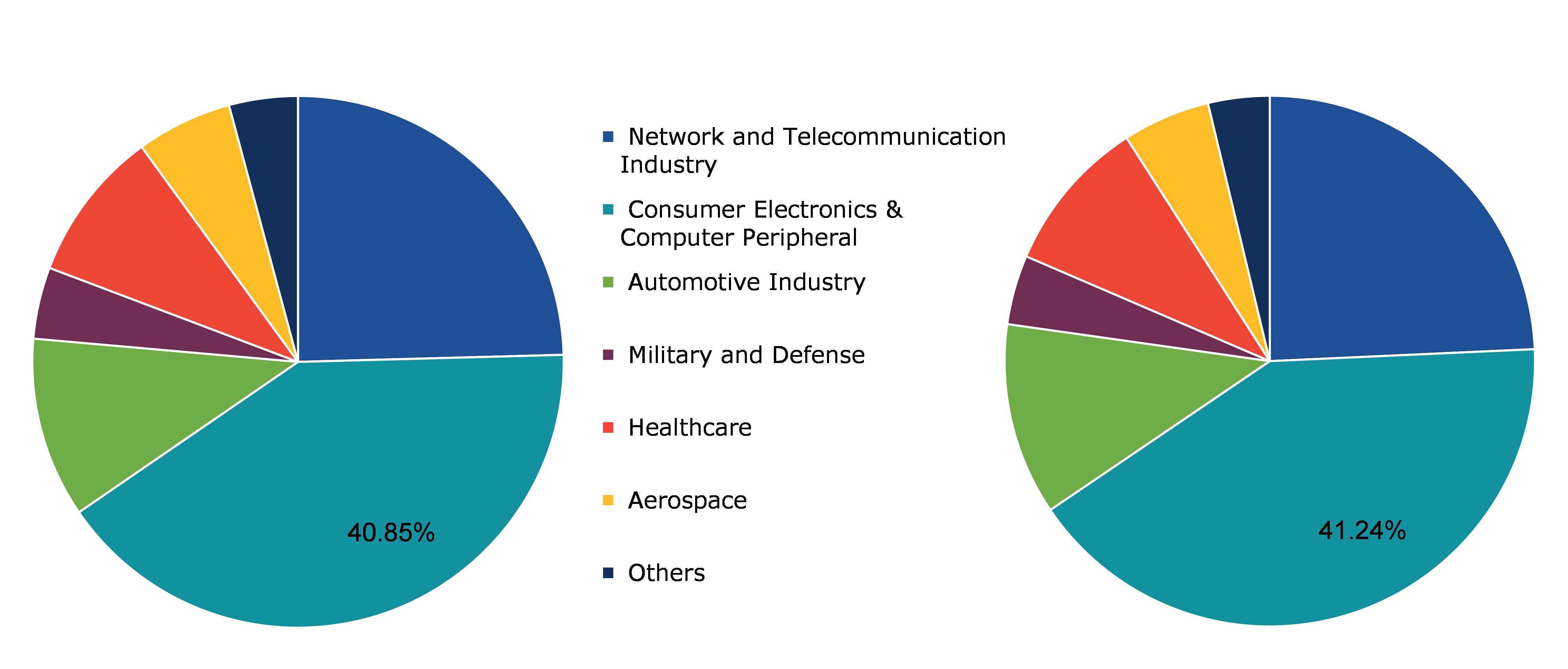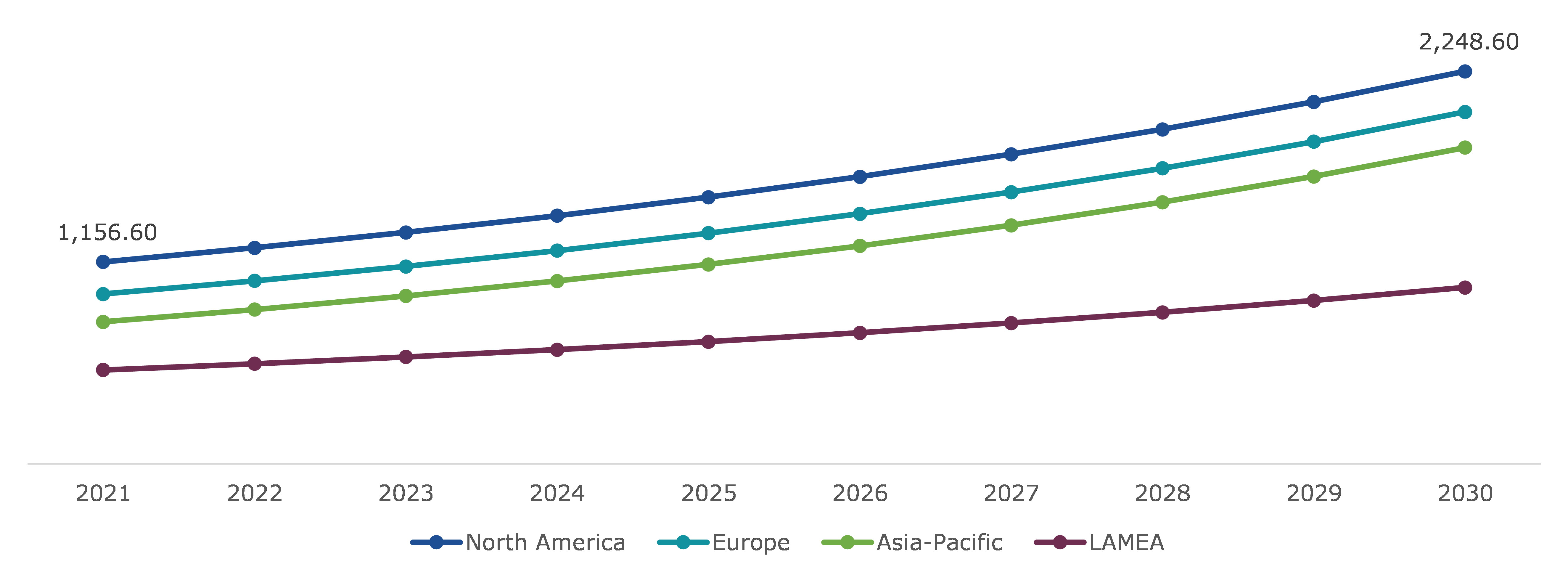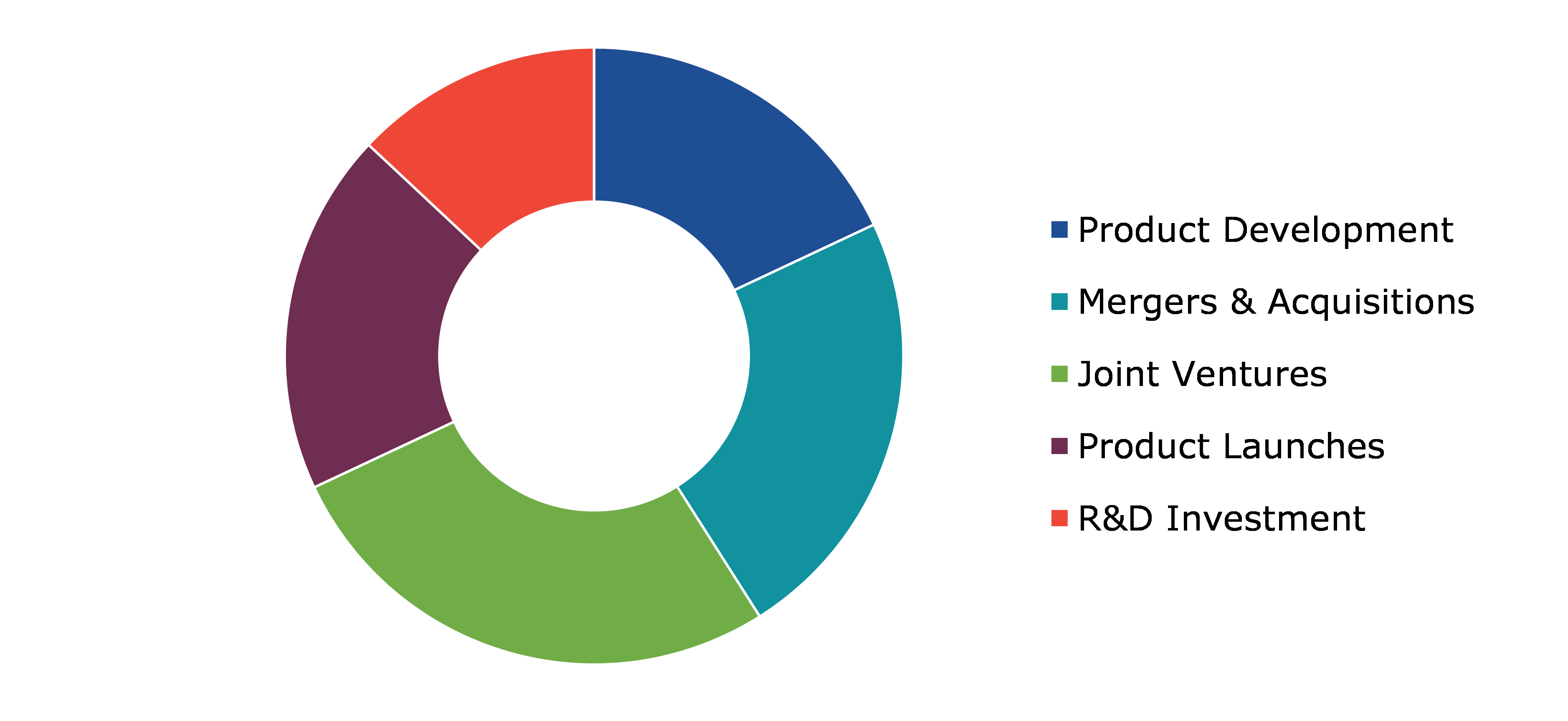Electrostatic Discharge (ESD) Packaging Market Report
RA08341
Electrostatic Discharge (ESD) Packaging Market by Product Type (Bags, Trays, Boxes & Containers, ESD Foam, ESD Films, and Others), End-user (Network & Telecommunication Industry, Consumer Electronics & Computer Peripheral, Automotive Industry, Military & Defense, Healthcare, Aerospace, and Others), and Regional Outlook (North America, Europe, Asia-Pacific, And LAMEA): Global Opportunity Analysis and Industry Forecast, 2022-2030
Global Electrostatic Discharge (ESD) Packaging Market Analysis
Electrostatic discharge (ESD) packaging market is projected to reach $7,086.70 million by 2030, growing from $3,480.5 million in 2021, at a CAGR of 8.31% in the forecast period
Global Electrostatic Discharge (ESD) Packaging Market Analysis
The rapid adoption of ESD packaging in a variety of end-use industries, such as defense and military, healthcare, manufacturing, automotive, and aerospace, is a major factor driving the global electrostatic discharge (ESD) packaging market. Furthermore, organizations' increasing investments in biodegradable electrostatic discharge packages is expected to open up lucrative potential for market growth throughout the forecast period.
Electrostatic discharge packaging is more expensive compared to other goods like anti-static bags and a few rub-off carbon black packaged products, which is expected to limit market growth over the projection period. Because the packaging is pricey and big, it is less affordable in the market. The packaging takes up a lot of space and is difficult to handle, which may limit the market's growth.
By region, Asia-Pacific market for electrostatic discharge packaging is expected to reach $1,812.10 million by 2030, growing from $813.40 million in 2021, at a CAGR of 9.39%. The regional growth is attributed to growing electrical and electronic gadgets and devices industries in the region which is also increasing the demand for electrostatic discharge packaging products.
Electrostatic Discharge (ESD) Packaging Market Overview
Electrostatic discharge packaging is made of plastic which helps in reducing the static electricity and protects electro-sensitive devices or products that contain inflammable gases or liquids due to a variety of causes like other gadgets, friction, and even the weather. The electronic devices are packed inside a rigid black polyethylene box with poly foam around the package. ESD packaging is made to keep static electricity at bay, thereby ensuring the integrity of the contents inside the pack.
ESD packaging is also a good idea in electronics since integrated circuits are made of semiconductor materials like silicon and insulating materials that might be damaged by high voltages. To avoid this problem, integrated circuit manufacturers and users must take measures and utilize the proper packaging materials and printing procedures.
COVID-19 Analysis on Electrostatic Discharge (ESD) Packaging Market
The pandemic is predicted to have a negative impact on the global electrostatic discharge packaging market. During the novel coronavirus outbreak, most of the electronic industrial sites were shut down due to the government-imposed lockdown. Also, the production of electronic devices was obstructed due to labor shortages, raw material supply, and other issues. These factors had a direct impact on the electrostatic discharge (ESD) packaging market. As the pandemic has forced certain industries to shut down, some temporarily and others permanently, the use of electrostatic discharge packaging has reduced drastically. However, predictions state that the demand for ESD packaging will increase after the pandemic settles.
Increasing Use of Electrostatic Discharge Packaging in Multiple End-use Industries is Predicted to be a Major Driving Factor for the Global Market
ESD packaging is used in automotive, defense & military, manufacturing, healthcare, and aerospace for various operational uses. With the help of ESD packages, the products can be securely transferred from one place to another, preventing electrostatic or static electricity from damaging electronic items in transit. When two differently charged items come into contact or even come close to one another, electrostatic discharge occurs. Electrostatic discharge can completely destroy any printed circuit board. Increased use of these packages by various end-use industries is predicted to drive the market in the forecast period. In addition, ESD packages provide safety to the product from inflammable liquids and gases. Such packaging materials are designed to promote the direct flow of electricity causing zero damage to the materials inside. ESD packaging is a safe and secure way of packaging which provides more safety as compared to other packages and hence, the market is predicted to grow in the forecast timeframe.
To know more about electrostatic discharge (ESD) packaging drivers, get in touch with our analysts here.
The cost of ESD Packages is Predicted to be a Major Restraint for the Electrostatic Discharge (ESD) Packaging Market
The cost of electrostatic discharge packaging is higher as compared to other products such as anti-static bags and a few rubs off carbon black packaged products, which is predicted to hinder the market growth in the forecast period. The packaging is expensive and bulky in nature, decreasing its affordability in the market. The packaging occupies huge spaces and is difficult to handle which can further restrain the growth of the market.
Biodegradable Electrostatic Discharge Package is Predicted to Create More Growth Opportunities for the Market in the Estimated Period
Increasing investments in biodegradable electrostatic discharge packages by a majority of companies is predicted to create more investment opportunities for the global ESD packaging market. The biodegradable packages cost less and are light weight in nature but these packages are in their experimental stages and need time to grasp the market. For instance, Croatia-based EcoCortec, in 2021, announced the world’s first biodegradable and compostable static-dissipative film.
To know more about Electrostatic discharge (ESD) packaging opportunity, get in touch with our analysts here.
Electrostatic Discharge (ESD) Packaging, by Product Type
Based on product type, the market is divided into bags, trays, boxes & containers, ESD foam, ESD films, and others. Bags sub-segment is predicted to have highest market share and ESD films sub-segment is predicted to have fastest growth.
Electrostatic Discharge (ESD) Packaging Share, By Product Type, 2021

Source: Research Dive Analysis
Bags product type sub-segment is predicted to have the maximum market share in the forecast period. Bags product type sub-segment accounted for $1,021.50 million in 2021 and is predicted to grow with a CAGR of 8.52% in the estimated period. Extensive utilization of ESD bags because it provides protection against ignition by dissipating charge build up is expected to drive the market growth. Also, manufacturers have focused on designing customized ESD packaging bags for easy transportation, which is predicted to drive the sub-segment market in the estimated period.
Electrostatic Discharge (ESD) Packaging Market, by End-user
Based on end-user, the market is segmented into network & telecommunication industry, consumer electronics & computer peripheral, automotive industry, military & defense, healthcare, aerospace, and others. Consumer electronics & computer peripheral is predicted to have the highest market share whereas automotive industry is expected to have fastest growth.
Electrostatic Discharge (ESD) Packaging Market Share, By End-user, 2021 & 2030
Source: Research Dive Analysis
Consumer electronics & computer peripheral end-user sub-segment is predicted to grow enormously in terms of revenue. Consumer electronics & computer peripheral sub-segment accounted for $1,421.70 million in 2021 and is predicted to grow with a CAGR of 8.43% in the estimated period. Consumer electronics & computer peripheral use the ESD packages to a large extent to procure and transfer electronic products from one place to another. Increasing uses of ESD packages across the industry in consumer electronic & computer peripheral is predicted to drive the sub-segment market in the estimated period.
Electrostatic Discharge (ESD) Packaging Market, Regional Analysis
Based on regional analysis, the market is studied across North America, Europe, Asia-Pacific, and LAMEA.
Electrostatic Discharge (ESD) Packaging Market Share & Forecast, By Region, 2021-2030 ($Million)
Source: Research Dive Analysis
The North America Region Market is Predicted to have Highest Market Share
The North America region market is predicted to have highest market share in the forecast period. The market in the North America region accounted for $1,156.60 million in 2021 and is predicted to grow with a CAGR of 7.76% during the analysis period. The increase in the adoption of technological devices in manufacturing and automobile industries has consequently boosted the need for transportation and adaptive packaging of these devices to protect them from damage. Thus, electrostatic discharge have seen a hike in their demand for the packaging of electrostatic-sensitive devices or products that contain flammable liquids or gases. Presence of large number of manufacturing units of these materials across the region is predicted to drive the regional market in the forecast period.
Key Participants in the Electrostatic Discharge (ESD) Packaging Market:
Product advancements, innovations, and business expansion are common strategies followed by major market players.
Source: Research Dive Analysis
Some of the significant electrostatic discharge (ESD) packaging market players include Smurfit Kappa Group, BASF, Desco Industries, DowDuPont, PPG Industries, TIP Corporation., Conductive Containers Inc., Elcom (UK) Ltd., Tandem Equipment Sales Inc., and Global STATCLEAN SYSTEMS.
| Aspect | Particulars |
| Historical Market Estimations | 2020-2021 |
| Base Year for Market Estimation | 2021 |
| Forecast timeline for Market Projection | 2022-2030 |
| Geographical Scope | North America, Europe, Asia-Pacific, LAMEA |
| Segmentation by Product Type |
|
| Segmentation by End-user |
|
| Key Companies Profiled |
|
Q1. What is the size of electrostatic discharge packaging market?
A. The global electrostatic discharge packaging market size was over $3,480.50 million in 2021 and is predicted to grow with a CAGR of 8.31% over the forecast period.
Q2. Which are the leading companies in the electrostatic discharge packaging market?
A. BASF and Conductive Containers Inc. are some of the key players in the global electrostatic discharge packaging market.
Q3. Which region possesses greater investment opportunities in the coming future?
A. Asia-Pacific region possesses great investment opportunities for the investors and is expected to witness the most promising growth in the coming years.
Q4. What is the growth rate of Asia-Pacific?
A. Asia-Pacific electrostatic discharge packaging market is projected to grow at 9.39% CAGR during the forecast period.
Q5. What are the strategies opted by the leading players in this market?
A. Product development is a key strategy opted by the operating companies in this antinuclear antibody testing market.
Q6. Which companies are investing more on R&D practices?
A. BASF is the company investing more on R&D activities for developing new products and technologies.
1.Research Methodology
1.1.Desk Research
1.2.Real time insights and validation
1.3.Forecast model
1.4.Assumptions and forecast parameters
1.5.Market size estimation
1.5.1.Top-down approach
1.5.2.Bottom-up approach
2.Report Scope
2.1.Market definition
2.2.Key objectives of the study
2.3.Report overview
2.4.Market segmentation
2.5.Overview of the impact of COVID-19 on Global electrostatic discharge (ESD) packaging market
3.Executive Summary
4.Market Overview
4.1.Introduction
4.2.Growth impact forces
4.2.1.Drivers
4.2.2.Restraints
4.2.3.Opportunities
4.3.Market value chain analysis
4.3.1.List of raw material suppliers
4.3.2.List of manufacturers
4.3.3.List of distributors
4.4.Innovation & sustainability matrices
4.4.1.End user matrix
4.4.2.Regulatory matrix
4.5.Porter’s five forces analysis
4.5.1.Bargaining power of suppliers
4.5.2.Bargaining power of consumers
4.5.3.Threat of substitutes
4.5.4.Threat of new entrants
4.5.5.Competitive rivalry intensity
4.6.PESTLE analysis
4.6.1.Political
4.6.2.Economical
4.6.3.Social
4.6.4.Technological
4.6.5.Environmental
4.7.Impact of COVID-19 on electrostatic discharge (ESD) packaging market
4.7.1.Pre-covid market scenario
4.7.2.Post-covid market scenario
5.Electrostatic discharge (ESD) packagings Market, by Type
5.1.Overview
5.1.1.Market size and forecast, by Type
5.2.Bags
5.2.1.Key market trends, growth factors, and opportunities
5.2.2.Market size and forecast, by region, 2022-2030
5.2.3.Market share analysis, by country 2022 & 2030
5.3.Trays
5.3.1.Key market trends, growth factors, and opportunities
5.3.2.Market size and forecast, by region, 2022-2030
5.3.3.Market share analysis, by country 2022 & 2030
5.4.Boxes & Containers
5.4.1.Key market trends, growth factors, and opportunities
5.4.2.Market size and forecast, by region, 2022-2030
5.4.3.Market share analysis, by country 2022 & 2030
5.5.ESD Foam
5.5.1.Key market trends, growth factors, and opportunities
5.5.2.Market size and forecast, by region, 2022-2030
5.5.3.Market share analysis, by country 2022 & 2030
5.6.ESD Films
5.6.1.Key market trends, growth factors, and opportunities
5.6.2.Market size and forecast, by region, 2022-2030
5.6.3.Market share analysis, by country 2022 & 2030
5.7.Others
5.7.1.Key market trends, growth factors, and opportunities
5.7.2.Market size and forecast, by region, 2022-2030
5.7.3.Market share analysis, by country 2022 & 2030
5.8.Research Dive Exclusive Insights
5.8.1.Market attractiveness
5.8.2.Competition heatmap
6.Electrostatic Discharge (ESD) Packaging Market, by End user
6.1.Overview
6.1.1.Market size and forecast, by end user
6.2.Network & Telecommunication Industry
6.2.1.Key market trends, growth factors, and opportunities
6.2.2.Market size and forecast, by region, 2022-2030
6.2.3.Market share analysis, by country 2022 & 2030
6.3.Consumer Electronics & Computer Peripheral
6.3.1.Key market trends, growth factors, and opportunities
6.3.2.Market size and forecast, by region, 2022-2030
6.3.3.Market share analysis, by country 2022 & 2030
6.4.Automotive Industry
6.4.1.Key market trends, growth factors, and opportunities
6.4.2.Market size and forecast, by region, 2022-2030
6.4.3.Market share analysis, by country 2022 & 2030
6.5.Military & Defense
6.5.1.Key market trends, growth factors, and opportunities
6.5.2.Market size and forecast, by region, 2022-2030
6.5.3.Market share analysis, by country 2022 & 2030
6.6.Healthcare
6.6.1.Key market trends, growth factors, and opportunities
6.6.2.Market size and forecast, by region, 2022-2030
6.6.3.Market share analysis, by country 2022 & 2030
6.7.Aerospace
6.7.1.Key market trends, growth factors, and opportunities
6.7.2.Market size and forecast, by region, 2022-2030
6.7.3.Market share analysis, by country 2022 & 2030
6.8.Others
6.8.1.Key market trends, growth factors, and opportunities
6.8.2.Market size and forecast, by region, 2022-2030
6.8.3.Market share analysis, by country 2022 & 2030
6.9.Research Dive Exclusive Insights
6.9.1.Market attractiveness
6.9.2.Competition heatmap
7.Electrostatic Discharge (ESD) Packaging Market, by Region
7.1.North America
7.1.1.U.S.
7.1.1.1.Market size analysis, by Type
7.1.1.2.Market size analysis, by End user
7.1.2.Canada
7.1.2.1.Market size analysis, by Type
7.1.2.2.Market size analysis, by End user
7.1.3.Mexico
7.1.3.1.Market size analysis, by Type
7.1.3.2.Market size analysis, by End user
7.1.4.Research Dive Exclusive Insights
7.1.4.1.Market attractiveness
7.1.4.2.Competition heatmap
7.2.Europe
7.2.1.Germany
7.2.1.1.Market size analysis, by Type
7.2.1.2.Market size analysis, by End user
7.2.2.UK
7.2.2.1.Market size analysis, by Type
7.2.2.2.Market size analysis, by End user
7.2.3.France
7.2.3.1.Market size analysis, by Type
7.2.3.2.Market size analysis, by End user
7.2.4.Spain
7.2.4.1.Market size analysis, by Type
7.2.4.2.Market size analysis, by End user
7.2.5.Italy
7.2.5.1.Market size analysis, by Type
7.2.5.2.Market size analysis, by End user
7.2.6.Rest of Europe
7.2.6.1.Market size analysis, by Type
7.2.6.2.Market size analysis, by End user
7.2.7.Research Dive Exclusive Insights
7.2.7.1.Market attractiveness
7.2.7.2.Competition heatmap
7.3.Asia Pacific
7.3.1.China
7.3.1.1.Market size analysis, by Type
7.3.1.2.Market size analysis, by End user
7.3.2.Japan
7.3.2.1.Market size analysis, by Type
7.3.2.2.Market size analysis, by End user
7.3.3.India
7.3.3.1.Market size analysis, by Type
7.3.3.2.Market size analysis, by End user
7.3.4.Australia
7.3.4.1.Market size analysis, by Type
7.3.4.2.Market size analysis, by End user
7.3.5.South Korea
7.3.5.1.Market size analysis, by Type
7.3.5.2.Market size analysis, by End user
7.3.6.Rest of Asia Pacific
7.3.6.1.Market size analysis, by Type
7.3.6.2.Market size analysis, by End user
7.3.7.Research Dive Exclusive Insights
7.3.7.1.Market attractiveness
7.3.7.2.Competition heatmap
7.4.LAMEA
7.4.1.Brazil
7.4.1.1.Market size analysis, by Type
7.4.1.2.Market size analysis, by End user
7.4.2.Saudi Arabia
7.4.2.1.Market size analysis, by Type
7.4.2.2.Market size analysis, by End user
7.4.3.UAE
7.4.3.1.Market size analysis, by Type
7.4.3.2.Market size analysis, by End user
7.4.4.South Africa
7.4.4.1.Market size analysis, by Type
7.4.4.2.Market size analysis, by End user
7.4.5.Rest of LAMEA
7.4.5.1.Market size analysis, by Type
7.4.5.2.Market size analysis, by End user
7.4.6.Research Dive Exclusive Insights
7.4.6.1.Market attractiveness
7.4.6.2.Competition heatmap
8.Competitive Landscape
8.1.Top winning strategies, 2021
8.1.1.By strategy
8.1.2.By year
8.2.Strategic overview
8.3.Market share analysis, 2021
9.Company Profiles
9.1.Smurfit Kappa Group
9.1.1.Overview
9.1.2.Business segments
9.1.3.Product portfolio
9.1.4.Financial performance
9.1.5.Recent developments
9.1.6.SWOT analysis
9.2.BASF
9.2.1.Overview
9.2.2.Business segments
9.2.3.Product portfolio
9.2.4.Financial performance
9.2.5.Recent developments
9.2.6.SWOT analysis
9.3.Desco Industries
9.3.1.Overview
9.3.2.Business segments
9.3.3.Product portfolio
9.3.4.Financial performance
9.3.5.Recent developments
9.3.6.SWOT analysis
9.4.DowDuPont
9.4.1.Overview
9.4.2.Business segments
9.4.3.Product portfolio
9.4.4.Financial performance
9.4.5.Recent developments
9.4.6.SWOT analysis
9.5.PPG Industries
9.5.1.Overview
9.5.2.Business segments
9.5.3.Product portfolio
9.5.4.Financial performance
9.5.5.Recent developments
9.5.6.SWOT analysis
9.6.TIP Corporation
9.6.1.Overview
9.6.2.Business segments
9.6.3.Product portfolio
9.6.4.Financial performance
9.6.5.Recent developments
9.6.6.SWOT analysis
9.7.Conductive Containers Inc.
9.7.1.Overview
9.7.2.Business segments
9.7.3.Product portfolio
9.7.4.Financial performance
9.7.5.Recent developments
9.7.6.SWOT analysis
9.8.Tandem Equipment Sales Inc.
9.8.1.Overview
9.8.2.Business segments
9.8.3.Product portfolio
9.8.4.Financial performance
9.8.5.Recent developments
9.8.6.SWOT analysis
9.9.Elcom (UK) Ltd
9.9.1.Overview
9.9.2.Business segments
9.9.3.Product portfolio
9.9.4.Financial performance
9.9.5.Recent developments
9.9.6.SWOT analysis
9.10.Global Statclean Systems
9.10.1.Overview
9.10.2.Business segments
9.10.3.Product portfolio
9.10.4.Financial performance
9.10.5.Recent developments
9.10.6.SWOT analysis
10.Appendix
10.1.Parent & peer market analysis
10.2.Premium insights from industry experts
10.3.Related reports
Electrostatic discharge (ESD) can create destruction in any sensitive electronics devices or electronic parts and modules. Therefore, ESD packaging is essential for any type of static-sensitive devices or components like circuit boards, power modules, and anything else that can be destructed by static electricity.
Most of the electronic devices are highly exposed to ESD that even a tiny amount of electricity can harm these devices. ESD packaging averts the transfer of electrostatic charges between two electronic devices, and safeguards them from any destruction. These days, several industries are using ESD packaging materials in huge quantities to shield several electronic devices. The speedy adoption of ESD packaging in a diversity of end-use industries, such as defence, military, manufacturing, healthcare, automotive, and aerospace, is massively driving the demand for electrostatic discharge (ESD) packaging materials. Additionally, manufacturing companies are greatly investing in recyclable ESD packaging materials, which is likely to pave way for profitable opportunities for the electrostatic discharge (ESD) packaging market in the years to come.
Newest Trends in the Electrostatic Discharge (ESD) Packaging Market
As per a report by Research Dive, the global electrostatic discharge (ESD) packaging market is expected to grow from $3,480.5 million in 2021 to $7,086.70 million by 2030. The electrostatic discharge (ESD) packaging market in North America is foreseen to grow rapidly with a CAGR of 7.76% from 2022 to 2030. This is mainly owing to the rising implementation of electronic devices in manufacturing and automobile sectors in this region, which has led to an increase in the requirement for the transportation and adaptive packaging of electronics devices to safeguard them from damage. North America is deliberated as the most rewarding market for the ESD packaging, due to the existence of huge number of manufacturing factories of ESD packaging materials in this region.
Market players are greatly investing in research and development to satisfy the mounting demand for electrostatic discharge (ESD) packaging. Some of the prominent players of the electrostatic discharge (ESD) packaging market are BASF, DowDuPont, TIP Corporation., PPG Industries, Conductive Containers Inc., Elcom (UK) Ltd., Tandem Equipment Sales Inc., Desco Industries, Global STATCLEAN SYSTEMS, Smurfit Kappa Group, and others. These players are focused on devising strategies, for instance, partnerships, mergers and acquisitions, innovative developments, and collaborations to attain a leading position in the global market.
For instance,
- In December 2020, Markforged, one of the leading producers of additive manufacturing platform for manufacturing and factory units, introduced Onyx ESD, a new high-strength composite material for the electronics manufacturing industry.
- In January 2022, Goplasticpallets.com, a leading independent supplier of Plastic Pallets, Plastic Pallet Boxes, and Plastic Containers in the UK, launched a novel range of plastic containers that have electrostatic discharge (ESD) properties to its prevalent automotive range.
- In April 2022, Fortify, a cutting-edge manufacturing firm creating a novel generation of high-performance products, launched the most rugged, high-temp ESD material available in AM, powered by Loctite, one of the foremost Henkel brands, a worldwide leader in industrial adhesive solutions.
COVID-19 Impact on the Electrostatic Discharge (ESD) Packaging Market
The unexpected rise of the COVID-19 pandemic in 2020 has plummeted the growth of the global electrostatic discharge (ESD) packaging market. This is mainly because many electronics manufacturing industries were forced to shut down during the lockdown. Moreover, the manufacture of electronic devices was hampered owing to unavailability of labours, raw material supply, and other problems during the crisis. However, with the relaxation of the pandemic by the end of 2021, many electronics manufacturing companies have resumed their processes, which indicates that a steep rise in the demand for ESD packaging is expected. All these factors portray that the global electrostatic discharge (ESD) packaging market is likely to have an auspicious future in the forthcoming years.
Personalize this research
- Triangulate with your own data
- Request your format and definition
- Get a deeper dive on a specific application, geography, customer or competitor
- + 1-888-961-4454 Toll - Free
- support@researchdive.com





